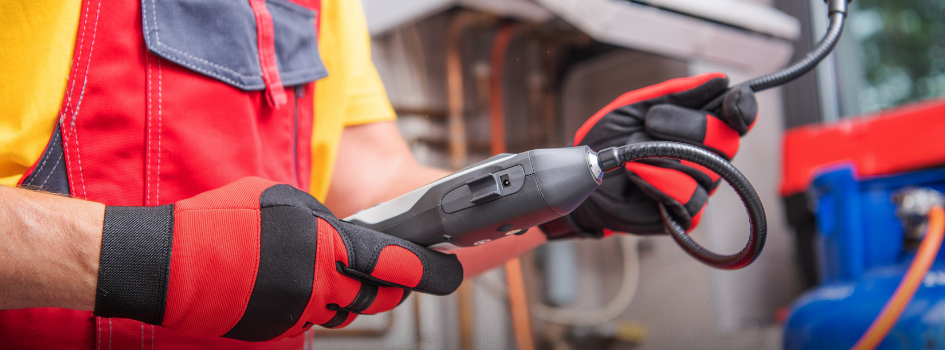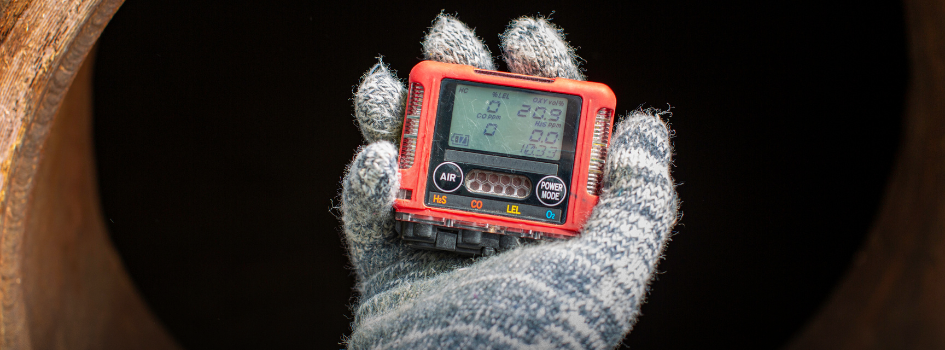
Gas Detection 101: Protecting Workers from Invisible Hazards
Gas detection isn’t something you think about until it fails…and by then, it’s too late. In industrial settings, gases like hydrogen sulfide or carbon monoxide can’t be seen or smelled, yet they can disable a worker in seconds. You can’t rely on your nose for this stuff. By the time you smell it, it’s already a problem.
Common Industrial Gases + Risks
There are three main categories of gases used/produced on job sites:
- Toxic gases: Hydrogen sulfide (H₂S), carbon monoxide (CO), chlorine (Cl₂). These harm the body even in small amounts.
- Combustible gases: Methane (CH₄), propane, hydrogen. These create explosion hazards when mixed with air.
- Oxygen hazards: Too little oxygen leads to asphyxiation; too much can accelerate fires. Many workers ignore oxygen readings…but that’s often what saves lives first.
How Gas Detection Systems Work
Gas detectors measure airborne gas concentration. They operate on two main principles: diffusion (air moves naturally across the sensor) and sample draw (air is pulled into the device using a pump).
Common sensor types include:
- Electrochemical sensors for toxic gases
- Catalytic bead sensors for combustibles
- Infrared sensors for combustible gases and CO₂
- Photoionization detectors (PID) for VOCs
Sensors degrade faster in dusty/humid environments. Check calibration schedules regularly. Skipping that is how detectors fail quietly.
Portable vs. Fixed Gas Detection
Portable detectors are personal devices worn on clothing or carried into confined spaces. They’re used for entry work, inspections, and maintenance. Fixed systems stay mounted in one location, continuously monitoring an area/process.
Never assume the fixed system is doing your job for you. Always carry your own monitor when entering a space.
Recommended Calibration & Maintenance Schedule
A consistent calibration and maintenance schedule keeps detectors reliable. While exact intervals depend on manufacturer and usage conditions, the following routine works for most industrial setups:
- Bump test: Before each use or at the start of each shift
- Full calibration: Every 30 days, or more often in dusty, wet, or temperature-extreme areas
- Sensor replacement: Every 12-24 months depending on type and exposure
- Filter/battery checks: During monthly calibration
- Docking station maintenance: Inspect and clean every quarter to maintain charging and communication
Document each test and calibration. Records should include date, technician name, gas type, and test results. A proper schedule prevents false readings and extends detector life.
A common mistake: ignoring a failed bump test. If your detector doesn’t respond to gas, it’s not detecting anything.

Alarm Settings & Response Procedures
Gas detectors use alarm thresholds: low, high, STEL (Short-Term Exposure Limit), and TWA (Time-Weighted Average). When the alarm sounds, move to clean air first, then assess the situation. Don’t panic.
Training should explain alarm meanings, evacuation routes, and communication steps. The best reaction is practiced, not improvised.
Types of Gas Detection Equipment
Gas detection equipment comes in several forms depending on application, mobility needs, and monitoring scale:
- Single-gas detectors for personal use, focused on one gas (such as H₂S / CO)
- Multi-gas detectors for multiple gases at once (oxygen, combustible gases, CO, and H₂S)
- Area monitors to stay in one place for extended operations (like shutdowns / maintenance zones)
- Fixed detection systems for large areas
- Wireless/connected devices that send live data to supervisors/control rooms
Make sure you always review sensor compatibility and cross-sensitivity charts before use. Consumer-grade detectors don’t hold up in industrial conditions.
Legal, Regulatory, and Training Requirements
OSHA, ANSI, and other agencies have strict rules for confined space entry, atmospheric testing, and exposure control. OSHA 29 CFR 1910.146 and 1910.1000 outline limits for toxic and combustible gases. NFPA and ISA provide direction on system design and performance for fixed detection setups.
Companies are expected to keep calibration and inspection records, as well as employee training documentation. Auditors look for proof that:
- Workers are trained.
- Instruments are calibrated.
- Test data is logged.
Those records often save you from citations…and they show you’re doing the job right!
Even with all the regulations, equipment alone won’t keep people safe. Workers need real hands-on training, not just some online videos. They should know what the alarms mean, how to test their detectors, and when to get out. Too many people read the manual after something goes wrong. Refresher sessions keep those habits sharp, especially for confined space rescue work or high-risk environments.
Training, compliance, and maintenance go together. If one fails, the whole program falls apart!
DXP Offers Expert Safety Services
Gas detection saves lives every day. The technology has improved over time, but it’s still only as reliable as the people maintaining and using it. You don’t get second chances with invisible gases. Respect the detector, and it’ll respect you. DXP Safety Services provides gas detection solutions to protect your workforce, plus we have 100+ years of safety expertise!
Contact our team today to speak to a safety expert.

